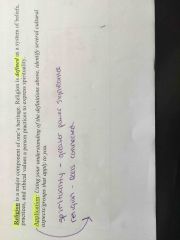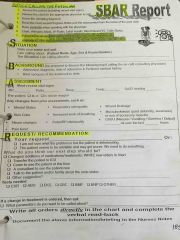![]()
![]()
![]()
Use LEFT and RIGHT arrow keys to navigate between flashcards;
Use UP and DOWN arrow keys to flip the card;
H to show hint;
A reads text to speech;
78 Cards in this Set
- Front
- Back
- 3rd side (hint)
|
Communication |
Ongoing, dynamic series of events that involves the transmission of meaning from sender to receiver. Exchanging words, gestures, and actions. |
|
|
|
Intrapersonal |
Self talk, Self verbalization, mental rehearsal. It improves your self esteem and health . Ex: grocery list |
|
|
|
Interpersonal |
Face to face . Exchanging of ideas, problem solving, team building. It uses interaction to assess understanding and clarify misinterpretation when teaching a patient about a health problem. |
|
|
|
Transpersonal |
Occurs within a persons spiritual domain. Many people use prayer, mediation, and guided reflection . |
|
|
|
Small Group |
Goal directed, understanding group dynamics. Cohesive and committed. Committees lead patient support group. Research team, or support group . |
|
|
|
Public |
Special adaptation in eye contact, gesture, voice, and inflections. Ex: audience; to talk about health related topics . (Classroom) |
|
|
|
Interdisciplinary |
Consists of patients (and family) and all healthcare personnel involved in providing care . Ex: discharge planning meeting |
|
|
|
Referent |
Motivates one person to communicate with another. Ex: signs, sounds, orders, messages |
|
|
|
Sender |
Person who encodes and delivers the message |
|
|
|
Receiver |
Person who receives and decodes the message. ;; senders message acts like a referent. Ex:tone |
|
|
|
Messages |
Content of communication contains verbal, nonverbal and symbolic language. Persons perception can distort the message . Ex:terms can mean 2 different things |
|
|
|
Channel |
Means of conveying and receiving messages through visual, auditory, and tactile senses. Ex:hands on |
|
|
|
Feedback |
The message the receiver returns |
|
|
|
Interpersonal variables |
Factors within both sender and receiver that influences communication. Ex: perception; patient might take nurses message differently. |
|
|
|
Environment |
Setting for sender-receiver interaction. Needs to meet participant needs for physical and emotional comfort and safety. Ex: education level, cultural background, gender, age, and medication . |
|
|
|
Intimate district and example |
0-18 inches. Ex:dressing change, ABLS, holding a crying infant, performing physical assessment. |
|
|
|
Intimate district and example |
0-18 inches. Ex:dressing change, ABLS, holding a crying infant, performing physical assessment. |
|
|
|
Personal distance and example |
18 inches to 4 feet Ex: sitting on a patients bedside, taking patients nursing history, exchanging info at change of shift |
|
|
|
Social distance and example |
4 feet to 12 feet Ex: making rounds with a physician, sitting at head of a conference table, teaching a class . |
|
|
|
Public distance and example |
12 feet and greater Ex: speaking at a community forum, testifying at a legislative hearing, public speaking |
|
|
|
Social zone ; body location and permission |
Hands, arms, shoulders, back. Permission NOT NEEDED |
|
|
|
Consent zone ; body location and permission |
Mouth. Wrist, and feet Permission NEEDED |
|
|
|
Vulnerable zone ; body location and permission |
Face, neck, front of body Permission NEEDED ; special cares needed |
|
|
|
Intimate zone ; body location and permission |
Genitalia and rectum Great sensitivity NEEDED |
|
|
|
Vocabulary |
Unsuccessful if sender and receiver cannot translate one another's words or phrases. Ex:children small vocab . "Dinner" -noon or last meal ? |
|
|
|
Denotative meaning |
Some words have several meanings. Meaning made due to shared common language. |
|
|
|
Connotative meaning |
A connotative meaning is the shade or interpretation of the meaning of a word influence by thoughts, feelings, or ideas people have about that word. Ex: same picture but experience might change meaning |
|
|
|
Pacing |
Conversation is more successful at an appropriate speed or pace. Talking to fast, pauses, and clear |
|
|
|
Intonation |
Tone of voice dramatically affects the meaning of the message . -ummmm -you know |
|
|
|
Clarity and Brevity |
Effective communication is simple , brief and direct. Fewer words= less confusion. Also non medical terms |
|
|
|
Timing and relevance |
Timing is critical in communication on teaching when patient seems interested vs when they are in pain. Teaching too soon. Patients have to see relevance |
|
|
|
Humor |
Important often underuse resources in nursing interaction; helps adjust stress. -know when appropriate -know good timing |
|
|
|
Pre-interaction Definition & Intervention |
Before meeting a patient . Ex: review qualible data (nursing history), talk to caregivers |
|
|
|
Orientation Definition & Intervention |
When the nurse and patient meet and get to know each other . Intervention: set the tone for relationship, recognize that the initial relationship, assess the patients health status |
|
|
|
Working phase Definition & Intervention |
When the nurse and patient work together to solve problems and accomplish goals. Intervention: encourage and help patients feelings,provide info needed to understand and change behaviors. |
|
|
|
Termination phase Definition & Intervention |
During the ending of the relationship. Intervention: remind patient termination is near. |
|
|
|
Socio-cultural status |
Culture influences thinking, feeling, behaving and communicating. Be aware of the typical patterns of interaction that characterize various cultures. |
Personal issues can be open or unopen |
|
|
Physical & emotional status |
Influence communication person with hearing or vision impairment often have difficulty receiving messages. Review patient's medical records. Stop if needed and learn to pick up cues |
|
|
|
First level of communication |
Cliché conversation. Requires least involvement as it does not require much thought. Ex: the weather, the TV, how they are . "How are you?" |
|
|
|
Second level communication |
Fact-reporting. Basically objectives and does not involve much interaction. Ex:patient reporting symptoms. |
|
|
|
Third level of communication |
Sharing personal ideas and judgment. Ex: sharing opinions |
|
|
|
Fourth level of communication |
Sharing of feelings (hopes, illness, dying, sex, death etc) Most therapeutic level. Empathy and conern self awareness |
|
|
|
Enculturation |
Socialization into ones primary culture as a child. Ex: Bilingual |
|
|
|
Acculturation |
Process of adapting to and adapting a new culture Ex: Second culture and learning that occurs when the culture of majority is gradually displaced by culture ••••• |
|
|
|
Assimilation |
To become absorbed into another culture in adapting its characteristics Ex: immigrants or forced |
|
|
|
Biculturalism or multiculturalism |
Occurs when an individual identifies equally with two or more cultures Ex: Canada |
|
|
|
Cultural Backlash |
Reject the culture. Ex: Amish |
|
|
|
Diversity |
Fact or state of being different Ex: race, education, gender, ethnicity, culture, sexuality |
|
|
|
Religion |
Is a major component of one heritage. Vegan is defined as a system of beliefs practices and ethnical values a person's practice to express spirituality. |

|
|
|
Culture |
The thoughts, communications, actions, custom, beliefs, values, and institutions of racial, ethnic, religious, or social groups concept that applies to the group of people who share the same values. |
|
|
|
Ethnicity |
Shared identity related to social and cultural heritage such as value, language, geographic space, and racial characteristics. NOT RACE. Ex: nursing student |
|
|
|
Subculture |
Various ethnic, religious, and other groups with distinct characteristics from the domain culture. Ex: single parent nursing student |
|
|
|
Socioeconomic culture |
Group similar and financial position or wealth education and or occupation who have similar status life style interest feelings attitudes language usage and or behavior |
|
|
|
Religious culture |
Refers to type of religious group what have specific values attitudes and or behaviors |
|
|
|
Family culture |
Consist of ways of living of thinking that contribute to the family and sexual aspects of group life |
|
|
|
Religion |
Is a major component of one heritage. Vegan is defined as a system of beliefs practices and ethnical values a person's practice to express spirituality. |
|
|
|
Emic worldview |
Insider are native perspective Ex: seaweed soup; needed for laceration. |
|
|
|
Etic worldview |
Outsiders perspective Ex: nurse didn't know you needed soup for laceration. |
|
|
|
Ethnocentrism |
Tendency to hold one's own way of life as superior to that of others •view life through own culture |
|
|
|
Discrimination |
Prejudicial out look, action, or treatment |
|
|
|
Cultural imposition |
Using one's own values and customs as an absolute guidance and interpreting behavior |
|
|
|
Prejudice |
Negative believe or preference that is generalized about a group that leads to "pre-judgment" |
|
|
|
Stereotyping |
Assuming all members of a culture or ethnic group or alike |
|
|
|
Culture shock |
Disorder that occurs in response to your translation from one culture setting to another. |
|
|
|
SOAP / SOAPIE |
S- subjective data (verbalization of patient) O-Objective data (that which was measured and observed) A- Assessment (diagnoses based on data) P- Plan (what caregiver plans to do) I- Intervention E- Evaluation |
|
|
|
PIE |
P- problem (deficient knowledge regarding surgery related inexperience) I- Intervention (provided booklet on postoperative nursing care) E- Evaluation (demonstrated TCDB exercises correctly) |
|
|
|
Flow sheets |
Allows you to quickly and easily enter assessment data about patient including VS and routine repetitive care such as meals, weights etc |
|
|
|
Kardex |
Portable "flip-over" file or notebook is kept at the nurses station. Most kardex have activity and treatment sections and nursing care plans |
|
|
|
Transcultural nursing |
Distant discipline developed by Leininger that focuses on the comparative Study of cultures to understand similarities and differences among groups of people |
|
|
|
Transcultural nursing |
Distant discipline developed by Leininger that focuses on the comparative Study of cultures to understand similarities and differences among groups of people |
|
|
|
Culturally Congruent Care |
Karabakh bits people's values life patterns and sets of meaning generated from the people themselves. Sometimes this differs from professional's perspective on care |
|
|
|
Transcultural nursing |
Distant discipline developed by Leininger that focuses on the comparative Study of cultures to understand similarities and differences among groups of people |
|
|
|
Culturally Congruent Care |
Care that fits people's values life patterns and sets of meaning generated from the people themselves. Sometimes this differs from professional's perspective on care |
|
|
|
Cultural Competent Care |
Process of acquiring specific knowledge, skills, and attitudes to ensure delivery of culturally congruent care. ASK ED . |
|
|
|
DAR |
D-data(both subjective and objective) A- action (nurse's intervention; med tx) R- response on patient (evaluation of effectiveness) |
|
|
|
Charting by exception (CBE) |
Only charting what is abnormal or significant changes. |
|
|
|
Critical pathways |
•multi-disciplinary •problem identified •interventions developed • expected outcomes communicated |
|
|
|
What's SBAR stand for ? |
Situation Background Assessment Request/Recommendation |

|

